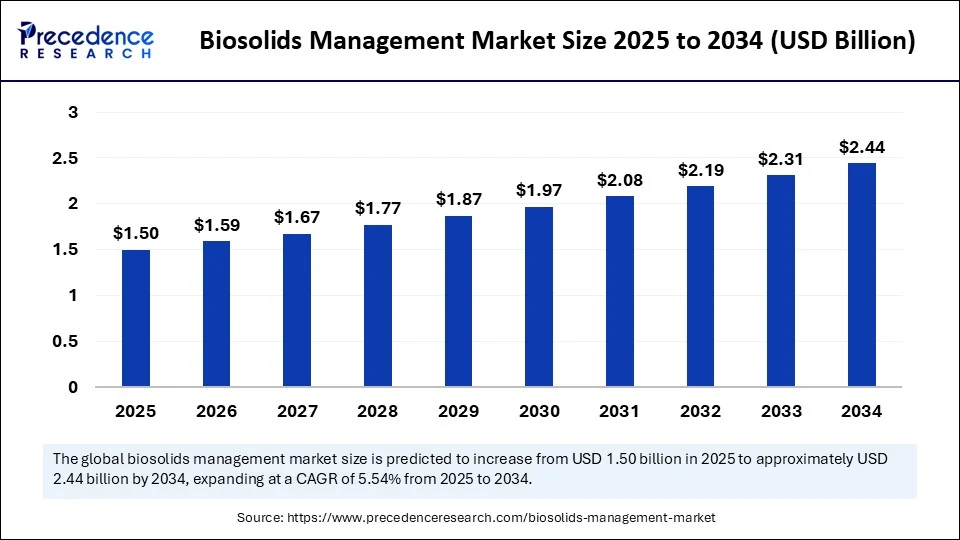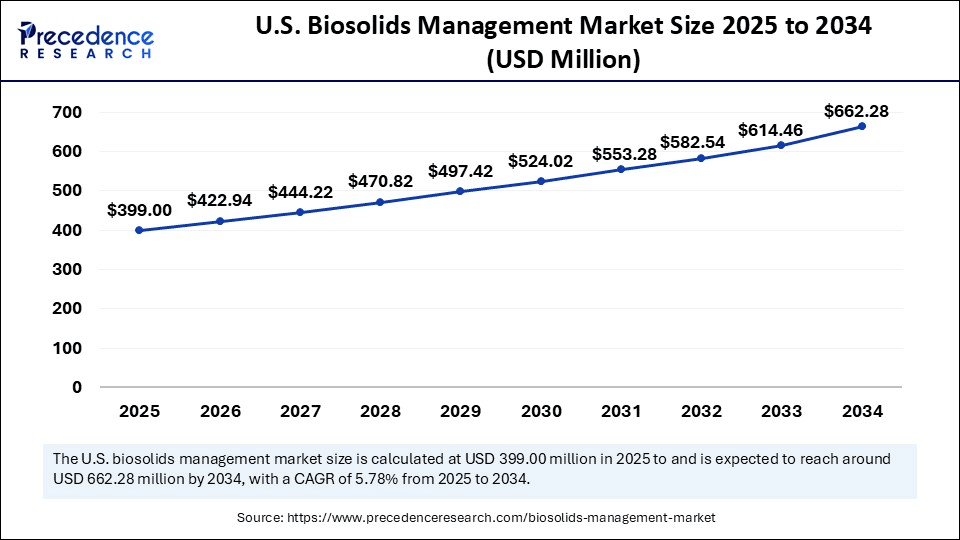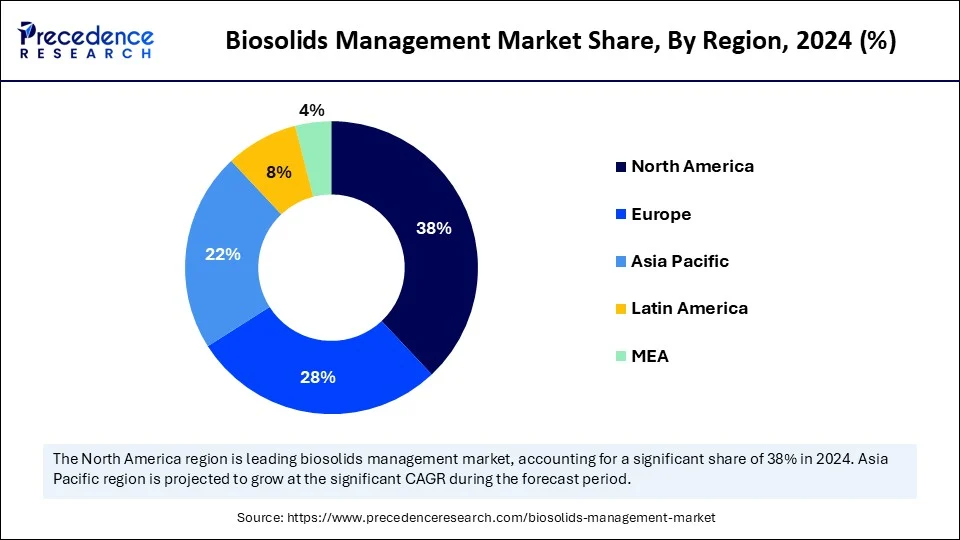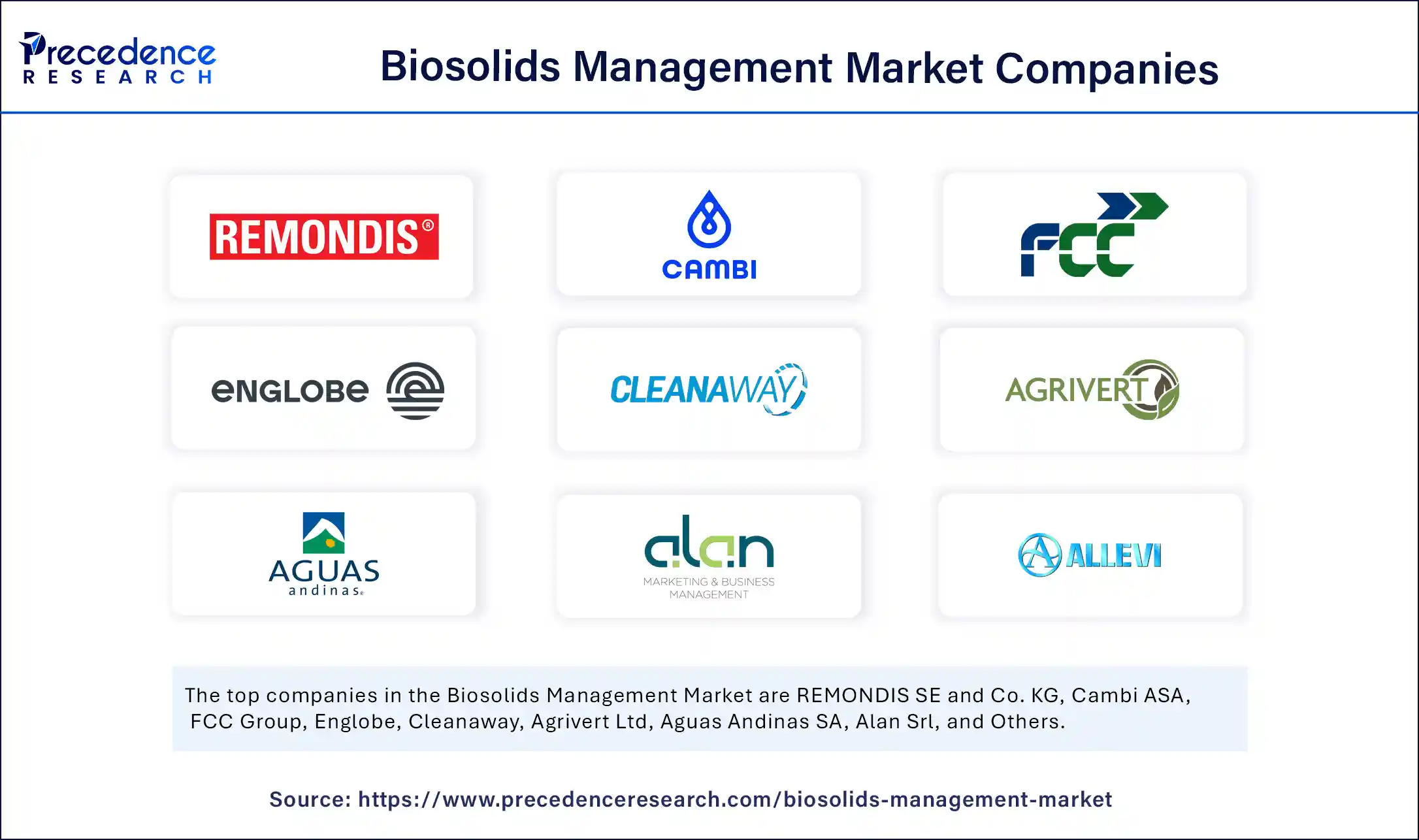List of Contents
Biosolids Management Market Size and Forecast 2025 to 2034
The global biosolids management market size accounted for USD 1.42 billion in 2024 and is predicted to increase from USD 1.5 billion in 2025 to approximately USD 2.44 billion by 2034, expanding at a CAGR of 5.54% from 2025 to 2034. The market is driven by the sustainability goals, regulatory compliance, agricultural demand, renewable energy opportunities, and technological innovations.

Biosolids Management MarketKey Takeaways
- In terms of revenue, the global biosolids management market was valued at USD 1.42 billion in 2024.
- It is projected to reach USD 2.44 billion by 2034.
- The market is expected to grow at a CAGR of 5.54% from 2025 to 2034.
- North America dominated the global market with the largest share of around 38% in 2024.
- Asia Pacific is anticipated to witness the fastest growth during the forecasted years.
- By process/treatment method, the anaerobic digestion segment led the market in 2024.
- By process/treatment method, the composting segment is anticipated to show considerable growth over the forecast period.
- By product type/quality, the class A segment has captured the biggest market share of 53% in 2024.
- By form, the cake segment contributed the highest market share of 44% in 2024.
- By form, the pellets segment is anticipated to show considerable growth over the forecast period.
- By application, the agricultural land application segment held the largest market share of 58% in 2024.
- By application, the energy recovery segment is anticipated to show considerable growth over the forecast period.
- By end-user, the municipalities segment generated the major market share in 2024.
- By end-user, the industrial facilities segment is anticipated to show considerable growth over the forecast period.
How is AI Integration Transforming the Biosolids Management Market?
Artificial Intelligenceis transforming the biosolids management market by bolstering efficiency and sustainability. The predictive analytics application for sludge-making can be used to predict the sludge volumes and determine optimum treatment timetables, and reduce operating costs. Automation AI also improves process control, allowing optimal energy consumption in technologies such as anaerobic digestion and thermal hydrolysis. Moreover, AI can be used in facilitating intelligent logistics through biosolids transportation predictions to minimize emissions and prices involved using large volumes of materials. The combination of AI with the municipalities and industries allows them to pass more stringent environmental standards more effectively, recovering as much as possible of the resources used. AI is advancing the industry in its shift toward more intelligent, cleaner, and more flexible biosolids management processes that would support global sustainability objectives.
U.S. Biosolids Management Market Size and Growth 2025 to 2034
The U.S. biosolids management market size was exhibited at USD 662.28 million in 2024 and is projected to be worth around USD 377.72 million by 2034, growing at a CAGR of 5.78% from 2025 to 2034.

Why Does North America Lead the Global Biosolids Management Market?
North America led the global market with the highest share of around 35-40% in 2024, attributed to its stringent regulations, well-established infrastructure, and widespread use of sustainable measures in managing its wastes. High environmental standards like the U.S. are driven by the principle of a circular economy, where municipalities and industries are focused on the reduction or, more often, elimination of landfill dependencies with the extraction of value in waste streams. Further, government financing and policy incentives also contribute to innovation and the adoption of highly advanced biosolids management solutions in the region.
The U.S. has a huge population, a lot of wastewater is generated, and the country has progressive environmental policies; it dominates the North American biosolids management market. Municipalities represent the main end-users because they process tremendously large quantities of sewage sludge daily in the urban centers. The U.S. has made enormous progress in using biological analogs for agricultural land imposition, renewable control, and land recovery projects. Further, infrastructure improvements are on the way with the help of public-private ventures and federal investment, which will make sustainable practices more readily adopted. The trend of increasing demand in organic fertilizers and the strict use and regulation of regulation usually favor the use of biosolids in farms.

Why is Asia Pacific Undergoing the Fastest Growth in the Biosolids Management Market?
Asia Pacific is estimated to grow at the fastest CAGR during the forecast period due to high population growth, rapid urbanization, and increased wastewater generation in major economies of China, India, Japan, and Southeast Asia. There is a massive change in the management of waste in the region, with governments spending heavily on new sewage systems so as to accommodate the growing sludge volumes. Industrialization and urbanization are increasingly straining overloaded systems, with a growing need to find reliable biosolids treatment and reuse systems to combat the problems. Further, environmental consciousness and its stringent regulations on waste management activities are stimulating local bodies and industries to use enhanced biosolids management.
China controls the biosolids management market in the Asia-Pacific region, owing to its large urban population, high rate of industrialization, and government-initiated efforts to focus on the environment. China has engaged in a number of sustainable national programs in waste management with vital emphasis on beneficial reuse, recycling, and stabilization of sludge. Also, the government is investing in anaerobic digestion and thermal drying to turn the sludge into renewable energy and safe fertilizers instead of relying on landfilling. The adoption is being boosted by the rise in attention to carbon neutrality and sustainable practices on the back of green development policies that China is implementing.
What Are the Key Trends Driving the European Biosolids Management Market?
The European biosolids management market is expected to account for a substantial market share in 2024. The growing trend in Europe has traditionally been to deal with sustainable biosolids management with regular demand because of strict environmental policies, high performance circular economy, and extensive investments by government and the industries in waste management facilities. The regulatory framework implemented by the European Union helps to strengthen the market as it focuses on lowering the dependence on landfills and on maximizing the recovery of resources in sewage sludge. The sustainability agenda of the region, coupled with improved treatment technologies, has created a steady environment where both the public and the operators in the private sector have extended biosolids solutions.
Germany is an example since having an active government regulation on its waste management sector has seen it embark on stringent measures to eliminate the use of untreated sludge on land, which in turn has seen more investments in advanced forms of treatment in sludge, such as the use of anaerobic digestion and thermal drying. The U.K. has also adopted circular economy approaches, where biosolids have been largely applied in farming as composts, and they have enabled the country to curb its overreliance on chemical fertilizers whilst maintaining the fertility of its soils.
Market Overview
Biosolids refer to the organic materials that are byproducts of the organic sludge sewage undergoing aerobic or other forms of digestion processes, as well as composting or drying of organic sludge. The market for biosolids management is experiencing massive changes as driven by changing consumer values and expectations and the increasing relevance of value-led and sustainable business models. Circular economy models are becoming increasingly popular globally, and biosolids can become an important part of it as it grows.
The increased awareness of environmental sustainability is among the fundamental growth factors, as governments and regulators worldwide are taking stringent measures towards creating awareness towards proper disposal and use of biosolids. Increased urbanization and population increase are also to be pointed out, as they increase the generation of sewage and increase the need for efficient wastewater treatment and biosolids management options. Also, the bio-solids are increasingly being used in the agricultural sector as a nutrient-rich and cost-effective alternative to chemical-based artificial fertilizers, beneficial to the soil health and crop output, in addition to being in line with sustainable farming.
What Factors Are Fueling the Rapid Expansion of the Biosolids Management Market?
- Tough environmental legislation: This regulation will compel municipalities and industries to adopt the use of high-tech biosolids management procedures, thus resulting in the expansion of the market, safety requirements, and sustainability maintenance.
- Urbanization and Increase in Population: Growing towns and their populations contribute to more sewage sludge and wastewater. This leads rising need for effective biosolids management systems due to an increase in waste generated.
- Increasing technological advances in the treatment procedures: Technological advances such as emerging methods of biosolid treatment, by use of thermal hydrolysis of biosolids, anaerobic digestion, etc., make a difference to biosolids management. These technologies result in higher use of pathogen reductions, odor control, and energy recovery, resulting in more safety and marketability of the biosolids.
Market Scope
| Report Coverage | Details |
| Market Size by 2034 | USD 2.44 Billion |
| Market Size in 2025 | USD 1.5 Billion |
| Market Size in 2024 | USD 1.42 Billion |
| Market Growth Rate from 2025 to 2034 | CAGR of 5.54% |
| Dominating Region | North America |
| Fastest Growing Region | Asia Pacific |
| Base Year | 2024 |
| Forecast Period | 2025 to 2034 |
| Segments Covered | Process/Treatment Method, Product Type/Quality, Form, Application, End-User, and Region |
| Regions Covered | North America, Europe, Asia-Pacific, Latin America, and Middle East & Africa |
Market Dynamics
Drivers
Rising Focus on Sustainable Waste Management
A key factor contributing to the growth in the global biosolids management market has been the growing trend to adopt sustainable waste management methods across the world. As cities grow and generate more wastewater, cities and municipalities have come under pressure to control sludge most efficiently and responsibly. The recycling of sewage sludge, through biosolids management, provides a sustainable waste management option because it transforms sewage sludge into a fertilizer rich with nutrients, which can be used in the form of a soil amendment, fertilizer, or even as a surrogate energy feedstock. The use of biosolids management in turning waste into a resource assists in lessening the harm to the environment, enhancing the condition of the soil, and thereby decreasing the reliance on fertilizers.
Restraint
Growing Concerns over Contaminants
The primary hindrance to the biosolids management market is the increasing concern about the presence of hazardous substances like heavy metals and pathogens, pharmaceuticals, as well as other emerging contaminants like polyfluoroalkyl substances (PFAS). Such chemicals heighten health and ecological risks to the soil, which is used to grow biosolids. Minimizing exposure to these risks has increased awareness, enhanced stronger surveillance, and more challenging regulatory requirements. At the municipal/industry level, this would translate into more treatment and testing costs to guarantee that biosolids are safe to reuse or dispose of. As this scrutiny becomes persistent, companies and treatment facilities are being required to invest in more advanced technologies to eliminate or neutralize the contaminants- something that, in the process, increases operational costs and makes it slows adoption.
Opportunity
Rising Government Regulations and Support
The biosolids management market offers great potential due to the growing governmental regulations and encouragement. Governments are enforcing strict rules regarding sewage disposal, and safe disposal and constructive reuse are highly promoted. The number of policies that promote the recycling of sewage sludge into biosolids is increasing in the U.S. and Europe to reduce the need to fill landfills and to conform to the circular economy objectives. The municipalities and private operators are being provided with financial support and incentives to upgrade infrastructure serving wastewater treatment. Such initiatives promote regulation on environmental practices and also spur innovation in more sophisticated forms of treatment like thermal hydrolysis, composting, and energy recovery systems.
Treatment Method Insights
Why is Anaerobic Digestion Leading the Biosolids Management Market?
The anaerobic digestion segment dominated the market in 2024. The process is associated with the degradation of organic material in the absence of oxygen and production of biogas, mainly gaseous methane, which can be utilized to generate electricity, heat, or be refined into a more renewable gaseous state known as renewable natural gas. In addition to energy recovery, anaerobic digestion results in stabilized biosolids, which can be used on the land safely. Regions with well-developed waste management infrastructure and more environmentally friendly policies toward renewable energy, such as North America and Europe, have become quite vulnerable to the presence of anaerobic digestion facilities. The circular economy idea for biosolid processing can increase environmental sustainability and the recovery of resources, as anaerobic digestion.
The composting segment is expected to experience substantial growth in the biosolids management market. There is mixing with bulking agents such as wood chips, straw, and sawdust in this technique, and then the previously mixed material is aerobically broken down using controlled decomposing conditions. The result is nutritious compost full of good bacteria, which could also be used as a chemical-free fertilizer. Composting, an internationally accepted green technology of recycling biosolids, is economically viable, and it has become very popular. This pattern is growing increasingly in favor of organic fertilizers, given that organic fertilizers rely less on chemical inputs to boost the fertility of the soil and the yield of crops. Composting also aligns with principles of a circular economy, i.e., the reuse of wastes to produce valuable products as well as reducing the volume of waste material entering landfills and contributing to greenhouse runaway.
Product Type/Quality Insights
Why is the Class A Segment Leading the Biosolids Management Market?
The class A segment led the market in 2024 because it is safe and versatile, and it meets high regulatory standards. A biosolid that has been treated to an advanced level of thermal hydrolysis, composting, pasteurization, or heat drying can reduce pathogens to an undetectable level. Class A biosolid enriches soils with their nutrient content besides organic materials, thereby enhancing soil fertility and agricultural productivity, alongside alleviating on chemical fertilisers and making farming sustainable. Their safety and quality are highly preferred in the developed areas, where the environmental regulations are strict on the use of pathogen-free biosolids on the land. The increased consumer awareness regarding food safety, soil health, and sustainable agricultural inputs is creating the demand for Class A biosolids.
Form Insights
Why Does the Cake Form Dominate the Biosolids Management Market?
The cake segment held around 40-45% market share in 2024, providing the material with the consistency of a solid or semi-solid. The popularity of this shape is the result of the ease of manufacture, cost-effectiveness, and ease of transportation. The major use of the biosolids cakes is agricultural land application due to their high nutrient value, which helps in crop production and improving soil fertility. Also, biosolids cakes have a smaller energy footprint during production compared to dried or pelletized products, which offers the strong implementation of the product across the developed and current economies. As the demand for sustainable and cost-effective utilization of that waste grows, the cake form of biosolids utilization remains dominant in the world.
The pellets segment is expected to grow substantially in the biosolids management market. A significant growth is also anticipated in the pellets segment as it relates to the market, where there is a growing demand for products manufactured using superior and user-friendly biosolids. Pellets are manufactured in a manner that biosolids are dried and granulated into even products that have low moisture content and thus are simple to handle, load, and apply. The unique characteristics of pellets, such as minimizing odor, enhanced storage stability, and the good looks of the pellets, make them most preferred in urban and residential tastes.
Application Insights
Why is Agricultural Land Application the Leading Segment in the Biosolids Market?
The agricultural land application segment led the market in 2024. Nutrients like nitrogen, phosphorus, and potassium that are essential and organic matter that make the soil structure and water holding capacity can be found in treated biosolids. Farmers and agricultural enterprises are increasingly showing interest in biosolids use to enhance the state of the soil, increase crop yields, and de-emphasize the use of chemical fertilizers. This has intensified, especially about the agricultural industry that is under pressure to become a sustainable farm and to preserve the health of the soil. Biosolids land application is the most prominent sector of the global market and will maintain its lead position in augmenting the total market considerably.
The energy recovery segment is expected to grow at a significant CAGR over the forecast period. The use of biosolids as a renewable energy feedstock is growing as a part of anaerobic digestion to produce biogas to heat and power, and thermal treatment incineration, gasification, and pyrolysis to produce electricity, syngas, or bio-oil. In other instances, plants attain a zero-energy scenario through the reabsorption of the power when doing operations. As many world governments seek renewable energy use and carbon reduction, energy recovery in biosolids, especially where the infrastructure and enabling regulations are being developed. Including renewable energy generation in the approach to sustainable waste management, this segment offers a significant growth potential to the biosolids management market.
End-User Insights
Why Do Municipalities Dominate the Biosolids Management Market?
The municipalities segment dominated the biosolids management market in 2024. The growing environmental regulation across borders has raised the demand for establishing the latest treatment technology, such as anaerobic digestion, composting, and thermal hydrolysis, to ensure that the waste materials are effectively secured and beneficially reused, as regulatory bodies in most parts of the globe insist. In addition to compliance, the treatment and management of municipal biosolids is also demonstrating a growing trend towards circular economy long-term thinking, where biosolids are being viewed as a resource. This trend is leading to efforts to recapture energy and nutrients and organic matter in biosolids into agriculture, landscaping, and renewable energy. Municipalities and their policy incentives have been a critical factor in biosolids management demand and innovation trends supported by government funding and public-private partnerships.
The industrial facilities segment is expected to experience substantial growth in the biosolids management market. Industrial plants, such as food processing facilities, pulp and paper plants, textile industries, and manufacturing plants, have become a new major consumer of biosolids management in that they produce a lot of sewage sludge. Increasing interest in the area of environmental sustainability and more stringent regulations in the field of waste disposal are forcing industries to develop efficient biosolids treatment and reuse methods. Combining biosolids management initiatives, such facilities are likely to reduce environmental effects, cut down on their costs of operation, and increase the rate of compliance with regulatory requirements. Industrial users are also being driven by social responsibility initiatives and an increasingly urgent need to show sustainable behaviour.
Biosolids Management Market Companies

- REMONDIS SE and Co. KG
- Cambi ASA
- FCC Group
- Englobe
- Cleanaway
- Agrivert Ltd
- Aguas Andinas SA
- Alan Srl
- Allevi Srl
- BCR Environmental
- C.R.E. – Centro di Ricerche Ecologiche
- Casella Waste Systems Inc.
- DC Water
- Eco-trass
- Synagro Technologies
- Lystek International
- Merrell Bros. Inc.
- Parker Ag Services LLC
- Recyc Systems Inc.
- Saur
Recent Developments
- In March 2024, Viridi Energy agreed to acquire a biosolids digester plant in Brunswick, Maine, to develop a renewable natural gas (RNG) plant. In collaboration with Casella Waste Systems, the company expects to process almost 85,000 tons of biosolids yearly with planned operations by 2026 to transform sludge into clean fuel.(Source:https://www.businesswire.com)
- In November 2023, Synagro Technologies, Inc., a leading company in offering biosolids and residuals solutions in North America, acquired New England Fertilizer Company (NEFCO), a privately held firm in Massachusetts. The acquisition brought to Synagro NEFCO customized client solutions and proven biosolids management technologies.(Source: https://www.synagro.com)
- In January 2023, Synagro Technologies, Inc., announced that it acquired substantially all of the assets of Burch Hydro, Inc., an Ohio-based firm with biosolids and lime-residuals management capabilities. Under this acquisition, Synagro added services to clean digester, dewatering, and land application of the company to more than 20 municipal clients.(Source: https://www.synagro.com)
Segments Covered in the Report
By Process/Treatment Method
- Anaerobic Digestion
- Aerobic Digestion (including heat drying)
- Composting
- Land Application
- Incineration/Thermal Treatment
- Landfilling
- Nutrient Removal/Recovery
By Product Type/Quality
- Class A (pathogen-free, safe for unrestricted use)
- Class A EQ (Exceptional Quality)
- Class B (less stringent, limited-use)
- Class AB/Intermediate
By Form
- Cake (dewatered solids)
- Liquid (high moisture)
- Pellet (dried, compact)
By Application
- Agricultural Land Application
- Non-Agricultural Land Application (e.g., landscaping, forestry, land reclamation)
- Energy Recovery (biogas production, heat/energy generation)
- Other uses (e.g., compost, industrial)
By End-User
- Municipalities (wastewater authorities)
- Industrial facilities (e.g., food processing, manufacturing)
- Farmers/Agricultural businesses
- Landscapers/Land restoration entities
By Region
- North America
- Europe
- Asia-Pacific
- Latin America
- Middle East and Africa
For inquiries regarding discounts, bulk purchases, or customization requests, please contact us at sales@precedenceresearch.com
Frequently Asked Questions
Ask For Sample
No cookie-cutter, only authentic analysis – take the 1st step to become a Precedence Research client